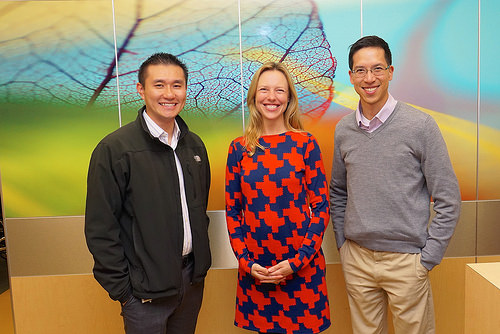-
Travis C. Spiecker's profile was updated 6 years, 2 months ago
-
Travis C. Spiecker's profile was updated 8 years, 9 months ago
-
Travis C. Spiecker wrote a new post on the site MIS4596 – Section 3 Spring 2015 9 years, 7 months ago

I created a post earlier in the semester that discussed what elements contribute towards “good” software; one of these elements is elegant design, which is lacking in software that is “clunky” as well as bothersome to navigate and use.
A component of design that is more specific and can be more easily analyzed is the user interface, which combines aesthetics with usability. I anticipate that creating a (somewhat) functional but polished user interface will be a challenge for project teams in general, so I located an article that describes what comprises a “successful” user interface.
The article’s author highlights clarity as “the most important element of user interface design” because it must simultaneously communicate meaning and function to users. Conciseness is the next most important element; it demands that designers be careful when adding explanations or definitions to their applications to avoid clutter and confusion. Professor Hohne called for a hybrid of clarity at conciseness while reviewing our prototype during a meeting on Tuesday: “I want to see green, yellow, and red status bars, not a whole lot of extra information.” With this remark, it became clear to me that a successful user interface may actually draw on the same principles as a successful status report document.
Having read through the linked article and this post, what steps should you take to keep your prototype’s user interface clear and concise? Will the responsibility of ensuring clarity and conciseness be left to one person on your design team, or to the entire team? Lastly, how might your approach differ if you had to produce a more complex application?
-
Travis C. Spiecker wrote a new post on the site MIS4596 – Section 3 Spring 2015 9 years, 7 months ago
In researching mentorship in the startup culture, I located a Forbes magazine article entitled “Why Entrepreneurs Need Good Mentors.” According to the author, a key benefit of having an accessible and […]
-
One lesson that my mentor from my internship passed along to me was that people bring value to projects in multiple ways. Whether it be through knowledge, technical skills, communication, sales, or expertise in a specific topic, everyone has something to bring to the table and help the project be successful. This is something that I try to keep in mind during every project, and is useful when group projects are going through a rough patch. Taking the time to reflect on how certain members can use their skill sets to help the project’s progress can really take a project to the next level, and improve the morale and success of the team.
-
-
Travis C. Spiecker commented on the post, Happy Birthday SNL // the typists from the Carol Burnett show, on the site 9 years, 7 months ago
I think that were the government to adopt an “autonomous cars only” policy, it would have to prepare the public for the policy over an extended period of time. First, legislation would be introduced that would force automakers to gradually decrease the proportion of new non-autonomous vehicles they manufacture, and the government would announce…[Read more]
-
Travis C. Spiecker wrote a new post on the site MIS4596 – Section 3 Spring 2015 9 years, 7 months ago

This week in class, we are discussing the art and science of integrative thinking. To learn more about integrative thinking, I explored online for relevant articles. On The Huffington Post’s website, I located an article entitled Becoming an Integrative thinker: The Keys to Success, by Roger Martin, the academic director of an institute of the University of Toronto’s Rotman School of Management and author of the article we read for class.
Martin uses the expression “opposable minds” to explain the decision-making styles of successful leaders; he explains that when faced with options, these individuals do not choose the lesser of two evils but instead synthesize a unique option that is superior to its alternatives.
More interestingly, in my opinion, he argues that integrative thinking is a skill rather than an innate ability—one that must be nurtured to develop, as opposed to one assigned by nature.
As I thought more about the prospect of developing one’s integrative thinking skills, I began to wonder what type of practice is best. Should one focus on case studies, or should one aim to tackle real-life problems? Should one type of practice precede the other, or is a mixture of the two optimal?
Lastly, do we already practice our integrative thinking skills more regularly than one might think?
-
Travis C. Spiecker wrote a new post on the site MIS4596 – Section 3 Spring 2015 9 years, 8 months ago

Last week in class, we discussed disruptive innovation at length, and we concluded that a key to surviving disruption is to quickly identify and respond to it. Companies that fail at either of these tasks may lose considerable market share, cash, talent, and value in the eyes of investor.
Because of our discussion, I became interested in identifying how a company can continually improve its business models to stay relevant in dynamic markets. My interest resulted in an internet search, and that search led me to an article on Bain & Company’s website entitled Repeatability: How companies create enduring businesses in a world of constant change. The article identifies a number of key principles that successful and enduring companies have in common—principles which result in what the authors call a “repeatable model” than embraces all aspects of change.
The principle that I found most interesting to examine was principle three of three: systems for closed-loop learning. These learning systems are driven by employee and customer input and are (I assert) representative of a Kaizen approach to process improvement. For a business model to be “repeatable,” it must not only encourage regular and proactive small-scale innovations, but also “develop early-warning devices that allow them to anticipate fundamental change in the marketplace.” I think that this latter point helps mitigate the need for forced, reactive changes to a company’s business model.
With the principle of closed-loop learning systems in mind, how might a start-up’s method of anticipating fundamental changes differ from a large corporation’s? What are the benefits of having a dedicated “office of restructuring” versus a distributed approach to innovation and threat identification? Why is employee empowerment important to a company’s culture of innovation?
-
Travis C. Spiecker commented on the post, Happy Birthday SNL // the typists from the Carol Burnett show, on the site 9 years, 8 months ago
I found the article you located to be intriguing, and I appreciated the balanced perspectives of Dr. Sundararajan—pro-uberization—and Dr. Reich—anti-uberization.
What worries me, to an extent, about the prospect of a largely “uberized” workforce, is the need for a worker to hold multiple jobs to compensate for the absence of full time emplo…[Read more] -
Travis C. Spiecker commented on the post, Five disaster-planning steps for small businesses to implement, on the site 9 years, 8 months ago
While all of the steps you listed are very important for organizations of all sizes, I think that the most critical step is to “survey your systems.” This step must include a review of all software and hardware infrastructure, as well as networks and data that a company relies upon for operation. In cataloguing its systems, a company should det…[Read more]
-
Travis C. Spiecker wrote a new post on the site MIS4596 – Section 3 Spring 2015 9 years, 8 months ago
Given that we will soon be expected to demonstrate progress on our project prototypes, I searched online for software prototyping tips. I found an article at a site called Inc about how develop a strong […]
-
Travis C. Spiecker commented on the post, How Company Size Relates to IT Spending, on the site 9 years, 8 months ago
I have no reason to believe that the findings are inaccurate, but there is a bias to the calculation of IT spending as a percentage of revenue; larger companies, by the article’s definition, have larger revenue streams than smaller companies. Thus, if two companies spend the same amount on IT, the larger of the two will spend less as a percentage…[Read more]
-
Travis C. Spiecker wrote a new post on the site MIS4596 – Section 3 Spring 2015 9 years, 8 months ago
In exploring project documentation techniques online, I found an excerpt from a software quality management book that illustrates the need for a balance between sufficient documentation and […]
-
Travis C. Spiecker commented on the post, Are Employees the Bigger Issue in Cyber Security?, on the site 9 years, 8 months ago
I agree that people are the most important (and weakest) component of information security measures; the other components are processes and technology. As we’ve discussed many times in MIS3535, and more recently in MIS4596 during our exploration of the value if IT investment, even the most sophisticated technology is useless (or burdensome) if…[Read more]
-
Travis C. Spiecker edited the doc Updated Project Charter 9 years, 8 months ago
-
Travis C. Spiecker commented on the post, How To Succeed When Your Boss Doesn't Have Time For You, on the site 9 years, 8 months ago
I think that employees should be careful in choosing whether or not to engage their boss in work-related conversation in their boss’s free time. Bosses with packed schedules may only have brief periods of time to themselves: quick walks through the office, elevator rides, and (possibly) lunch breaks. Encroaching on these times may sour your b…[Read more]
-
Travis C. Spiecker wrote a new post on the site MIS4596 – Section 3 Spring 2015 9 years, 9 months ago

Today in class, we debated the commoditization of information technology, an idea largely attributed to author Nicholas Carr. Our debate piqued my interest, so I aimed to investigate what businesspeople and technologists thought about Carr’s bold statement. My search brought me to page 99 of Carr’s personal blog, which gave me insight into just how large of a “splash” the article made in the business and technical communities. Unsurprisingly, the most fiery rebuttals came from heads of organizations centered around IT innovation (“IT ‘Is’ the Business”-type companies). Carr provides a link to an article detailing the manner in which Intel’s CEO “fires back” with an opposing viewpoint. Carr subsequently quotes Bill Gates as proclaiming that IT would not matter only if technology were perfect or simply could not be improved further; both conditions, obviously, do not describe contemporary IT.
In my exploration of the topic, I became more sure of my own stance. Particularly, I dislike Carr’s claim that IT is “no longer a source of advantage at the firm level.” Through innovation, a company can certainly gain a short-lived advantage over other firms. Perhaps what Carr more precisely means (at the risk of putting words in his mouth) is that IT alone does not result in a sustainable competitive advantage, a condition that many of us are discussing in BA4101. In other words, a single IT innovation only results in a limited and brief advantage over rivals.
To prompt further discussion, I offer this question: how can a business encourage and attain sustainable IT innovation? What types of cultural, financial, and motivating factors might promote such an endeavor?
-
Travis, I agree with you that IT still can provide a company with a short-lived advantage through innovation. I also agree with the notion (whether or not you were putting words in his mouth) that IT alone does not result in sustainable competitive advantage. It’s one thing to just have an IT system in place – that will at least put your company on the same level as every other company that utilizes IT. In that sense, Nicholas Carr’s analogy to train tracks does hold some truth. Where IT differs though is that it’s not confined to just one main task (train tracks will only be used for trains to move on, for example). IT can be utilized to make a wide array of business functions and solutions more efficient and effective. When used effectively, IT still does matter.
As for your discussion question, I think the best thing any business can do to ensure sustainable IT innovation is to constantly look at the system in place and think, “How can we make this better? Are there processes we can improve on? Are there any new technologies out there that we can benefit from using?” Constant evaluation can lead to innovation strategies for improving the business’s IT system. Motivating factors in this case would be the competitive advantages from consistently making improvements and changes, and also happier employees who feel their suggestions make a difference in the business.
-
-
Travis C. Spiecker commented on the post, ICE 5.1 Telling a Story through Visualization, on the site 9 years, 9 months ago
I agree with Erin in that the size of a company determines the viability of a flat organizational structure; a large company needs more structure to operate, whereas a small company does not require as much. In a small company, employees are also generally more knowledgeable about the skill sets of other employees (simply because there are fewer…[Read more]
-
Travis C. Spiecker commented on the post, NIST 800 60 V1R1 Guide for Mapping Types of Information and Information Systems to Security Categories, on the site 9 years, 9 months ago
To expand on Jacklin and John’s points regarding handouts, I agree that handouts that contain only a presentation’s main points are the most effective. When studying for tests in lecture-based classes, I prefer reviewing handouts that outline main points to having to trudge through pages of my notes (most of which was copied directly from the…[Read more]
-
Travis C. Spiecker and
 Jesse Worek are now friends 9 years, 9 months ago
Jesse Worek are now friends 9 years, 9 months ago -
Travis C. Spiecker and
Thomas F. Huang are now friends 9 years, 9 months ago
- Load More
Connect and innovate with an elite information systems program
Footer
MANAGEMENT INFORMATION SYSTEMS
Fox School of Business
Temple University
210 Speakman Hall
1810 N. 13th Street
Philadelphia, PA 19122



